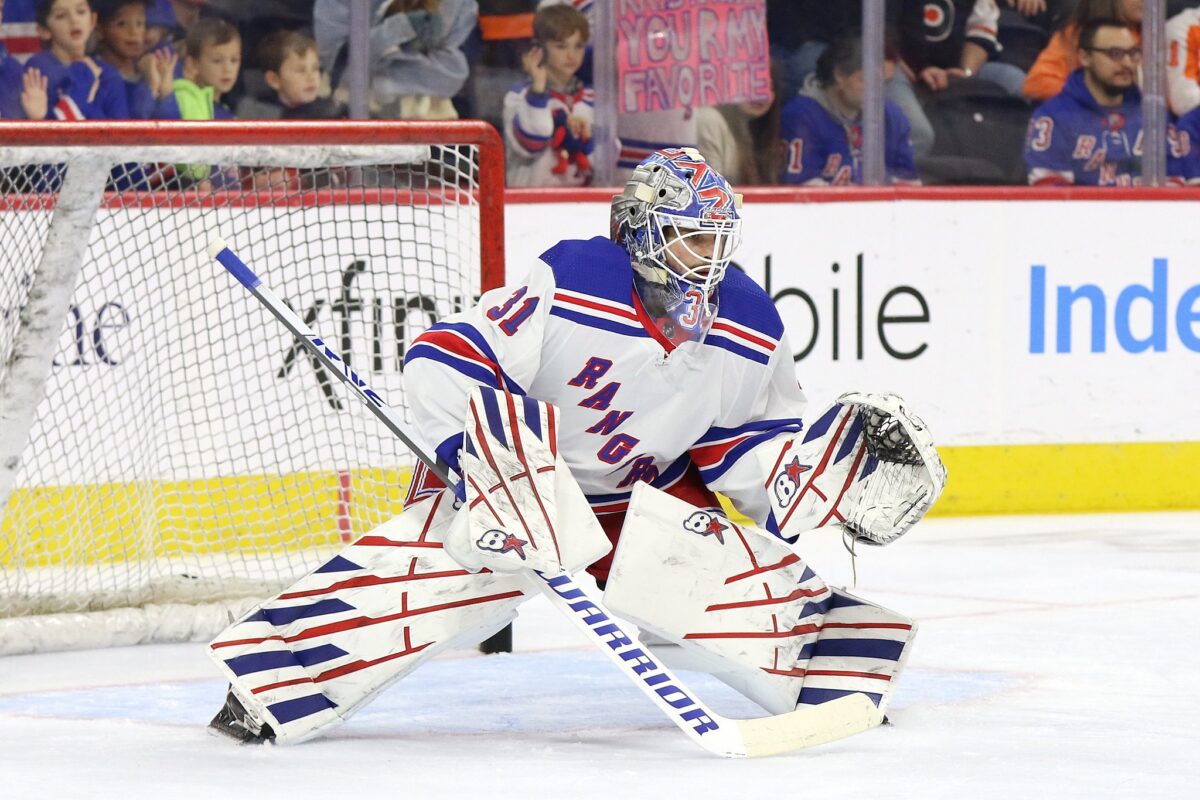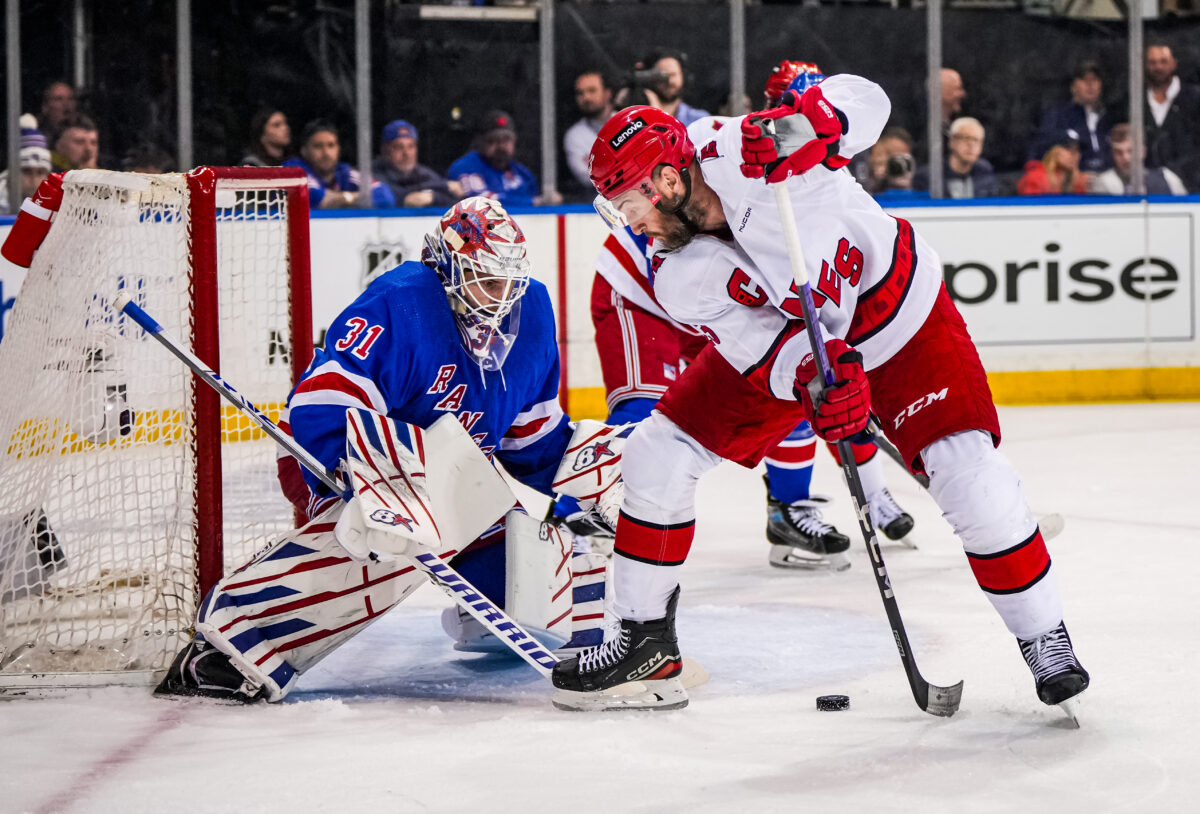Igor Shesterkin has apparently made what was a widely-expected choice.
In reportedly rejecting the New York Rangers‘ contract offer that would have made him the highest-paid goaltender in NHL history, both in average annual value and total money, the 28-year-old has opted to press his significant leverage to obtain a deal that would pay him not just as the best at his position, but as one of the best players in the league.
Saying no to an eight-year, $88 million extension just before training camp ended, it’s clear that it’s going to take at least an extra million per season, and perhaps more, for the Rangers to get Shesterkin’s signature on the dotted line. Fully understanding the rising costs for superstars with the salary cap finally poised to start to moving upward on a yearly basis again, along with their client’s outsized importance to his team, Shesterkin’s representatives are pushing to reset the traditionally depressed goalie market in passing on a deal that would have beaten Carey Price’s record $10.5 million AAV that for now, remains the high-water mark for netminders.
Doing so is Shesterkin’s right and a study in free-market economics. Set to become an unrestricted free agent at season’s end, the player has a unique opporturnity to maximize his value in a way that was going to make him the highest-paid at his position, be it for the Rangers or another team. He and his camp are correct that another team will top the $11 million AAV number that the Rangers reportedly presented, though the Blueshirts maintain the advantage of being the only team that can offer him an eighth year.
Ultimately, the Blueshirts will probably cave to Shesterkin’s demands. They’re a very good team, but one with a tradition of relying heavily on the star goalies they pump out of their farm system. While some contenders are able to thrive without a big-money player in net, Shesterkin’s brilliance has likely been the difference between the Rangers being a consistent first-round playoff exit and one that still appears to be in the conversation to win the Stanley Cup.
That makes the 2022 Vezina Trophy winner, who opened the 2024-25 season with a 29-save effort in a 6-0 victory over the Pittsburgh Penguins on Oct. 9, perhaps just as valuable as he thinks he is to his current club. He’ll get close to what he wants to stay in New York. What he might not get for all that money is a better chance to win championships there.
Shesterkin’s Next Cap Hit Might Eclipse McDavid’s for One Season
It seems at least possible that Shesterkin will best Connor McDavid’s $12.5 million AAV. Perspective is required here, of course, as McDavid is woefully underpaid now, given the rise in salaries since he signed his eight-year, $100 million contract that kicked in for the 2018-19 season. That said, the 2025-26 season could see a goalie paid more than the world’s most dynamic player, which will obviously change with McDavid able to become a UFA in summer 2026.
Shesterkin deserves to be paid more than Price, whose career is over due to injury and who is finishing out his contract on long term injured reserve. His statistics are better than those of the Tampa Bay Lightning’s Andrei Vasilevskiy ($9.5 million AAV) and the Florida Panthers’ Sergei Bobrovsky ($10 million), two contemporaries who are in the conversation with Shesterkin as top players at their position – and who are paid accordingly.

The difference between Shesterkin and those two, however, is a glaring one. Vasilevskiy and Bobrovsky are Stanley Cup winners; Shesterkin, for all he’s been able to do for the Rangers, is not. That’s because the two Florida teams possessed better rosters than the Blueshirts currently do when they won championships – which was readily apparent when Tampa Bay eliminated Shesterkin and the Rangers in the 2022 Eastern Conference Final, and the Panthers did the same in 2024.
Shesterkin shined in both of those postseasons, posting save percentages of .929 and .926, respectively. He was especially exceptional against Florida last spring, keeping the Rangers in games even as they were thoroughly outplayed by a bigger, stronger, deeper opponent.
Like Henrik Lundqvist before him, Shesterkin has been his team’s best player through a window of Stanley Cup contention, and thus deserves to be paid as such. That, however, creates a conundrum for him, fairly or not – if he insists on getting paid as much as he can by the Rangers, the club’s chances of upgrading the roster around him diminish.
Again, that’s not his fault. Shesterkin, though, has carried this good-but-not-great roster to within six wins of a title twice in the last three years. Will the Rangers be able to improve the supporting cast around Shesterkin enough to remain in the running for Cups if a goaltender – a player that traditionally doesn’t get paid the big bucks – is taking up the largest portion of their cap over eight seasons?
Edmonton Oilers star Leon Draisaitl will be the NHL’s highest-paid player for the 2025-26 season due to his recently signed extension that carries a record $14 million cap hit (before teammate McDavid certainly eclipses that the following season). Draisaitl will take up more than 15 percent of the Oilers’ cap when the deal starts. If the Rangers pay Shesterkin $12-13 million per, and the salary cap rises to $92-93 million for 2025-26 (a similar increase to the $4.5 million jump from 2023-24 to 2024-25), he’ll account for around 13 percent.
Shesterkin’s responsibility to the Rangers is to stop the puck, not build the roster. Yet one needs look no further than this past offseason when, hamstrung by expensive contracts for their core players, the club was unable to make significant personnel upgrades – the kind required to help them over the hump that they couldn’t get over in the ’22 and ’24 postseasons.
Related: 4 Rangers That Could Win NHL Awards This Season
Should Shesterkin sign for $12 million or so, he and star forward Artemi Panarin ($11.6 million AAV) would take up about a quarter of the Rangers’ cap for the 2025-26 season, when Shesterkin’s huge raise from his current $5.67 million hit will kick in.
So is it on Shesterkin to take a little less to make his team more competitive? Of course not. Fans who complain that any player is “selfish” for wanting to make as much money as they can and should take a “discount” that amount to millions of dollars would never do so themselves.
A Huge Contract For Shesterkin Means the Rangers Making Cuts Elsewhere
The reality, though, is that in wanting to be paid one of the highest salaries in the league, Shesterkin makes it less likely that the Blueshirts will be as competitive as they could be with a more manageable salary cap. Even with superstars McDavid and Draisaitl on what amount to bargain contracts (there’s no better deal in the league than Draisaitl’s current $8.5 million cap hit), the Oilers fell short in the 2024 Stanley Cup Final against the Panthers, who despite being pushed to a seventh game, had more quality depth. There’s reason to doubt how consistently Edmonton will be able to assemble Cup-winning rosters if McDavid re-ups with them, which will leave the Oilers with two superstars who eat up more than 30 percent of their cap.
Though it was a different time, the powerhouse New Jersey Devils of the mid-1990s and early-2000s had a number of key players who took less on extensions, allowing the team more financial flexibility to remain annually competitive. The result was three championships from 1995-03.
Hardly anyone would do what the New York Knicks’ Rick Brunson did in leaving $113 million on the table on his extension, the star guard prioritizing a comfort level with his team and the desire to give the organization the financial wherewithal to further build the Knicks into a championship club. Shesterkin shouldn’t be expected to do that either.

The fact is, though, that being paid as his team’s most important player – and commensurate with his belief that he’s one of the best in the league – means that the team will have to skimp elsewhere. In addition to opening the vault for Shesterkin, the Rangers have to find ways to make the money work for extensions for young cornerstones K’Andre Miller, Alexis Lafreniere and Braden Schneider next summer. That means relying more on minimum-salaried vets and youngsters on entry-level contracts in other key spots. Will the Rangers be able to assemble enough quality around Shesterkin that way?
Lundqvist carried the Rangers into the 2014 Cup Final and to Game 7 of the 2015 East Final. Both times, a better team dashed their dreams of a title, and The King never reached the top of the championship mountain. Will the Blueshirts acceding to the salary demands of their next great goalie result in a a similarly brilliant but Cup-less legacy in New York for Shesterkin?
Given his importance to the franchise and the consequences of not re-signing him, it seems likely that the Rangers will have little choice to find out just how far a big-money goalie – theoretically, the biggest – can carry them toward an elusive championship parade into the future.
